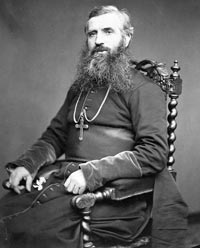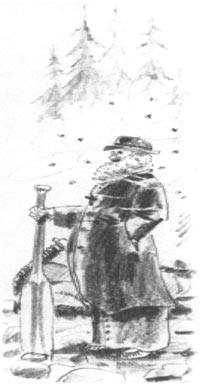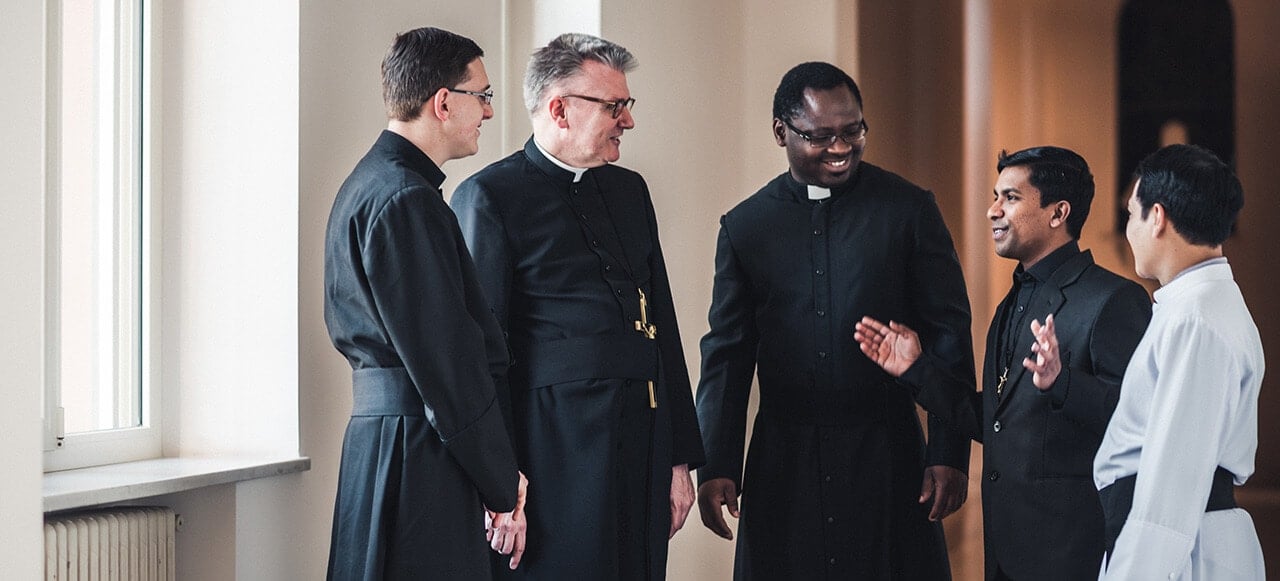
Isidore CLUT
Of all the great bishops who enriched the missions of Western Canada perhaps the least known is Bishop Isidore Clut. Yet, several aspects of his personality deserve to be recalled.
Who was this man who became known at “the bishop of the poor”? Isidore Clut was born in 1832 in Saint-Robert, diocese of Valence, France. After entering the Oblate Novitiate of Notre Dame de l’Osier, he pronounced his perpetual vows on December 8, 1854. It was on the same day that the dogma of the Immaculate Conception was proclaimed. He was then sent to Canada, and ordained to the priesthood at Saint-Boniface by Bishop Alexandre Taché on December 20, 1857. One year later he began his missionary career under the direction of Father Henri Faraud, his intructor in Montagnais.
Destitution and poverty
Father Isidore’s elevation to the episcopacy was very unconventional, and far from customary practice. Bishop Faraud, when passing through Rome, had asked Pope Pius IX for an “auxiliary” bishop. The Holy Father handed him a blank papal bull without indicating a designee. After a simple consultation with the missionaries of his vicariate the bishop chose Father Clut. It took two more years before the ceremony of consecration could be held, and under what conditions! On November 15, 1867, after many delays, the ceremony took place at the Nativity mission by Athabaska Lake. Bishop Faraud was the only consecrating bishop, assisted by two Oblates, Fathers Germain Eynard and Christophe Tissier. Someone had forgotten to bring a miter and crosier for the new bishop. No problem! Bishop Faraud sought out a small fir tree in the nearby woods that he simply hewed down and polished. He cut a spiral at the end of a plank and added it for a makeshift, but convenient. crosier. The Grey Nuns hastily sewed together the semblance of a miter, then decorated the small chapel with streams of crepe paper. The Holy Oils flowed on Isidore’s head and over his beard. It was a valid consecration. He really became the “bishop of the poor” as he was already fulfilling his heraldic device: “My yoke is sweet and my burden light.”

The all-around handy beard
The bishop was proud of his beard. Bushy, plentiful and curly, it flowed majestically down to his chest. It added to his already imposing stature an authority that the Amerindians dared not question. This graying fleece proved to be very useful against the cold in winter, and against mosquitoes in summer. During the warm season mosquitoes become a veritable martyrdom for the missionaries. This is how one missionary described them: “They are voracious, they envelop you, they harass you, and exasperate you. They swarm in by hundreds on every part of your body that is exposed to their darts. They buzz in your ears, go into your nose, sting your skin and feast on your blood.”
During a voyage by horse drawn wagon, Father Joussard ‘s team became mired in mud. As he was newly arrived in this region he could not succeed in defending himself against the swarm of mosquitoes that came at him from all sides. The poor man was stirring about like a devil in holy water. Fortunately, Bishop Clut was there to advise him. Under the protection of his beard, and with his greater experience, he exhorted: “Stop that struggling. Tie your mosquito netting carefully, to prevent a new army from breaking in. Then, kill those on the inside. You’ll get the hang of it.”
On the following night, young Father Joussard, in a fit of delirium, believed he was hanging on to his recalcitrant horse’s mane. He was yelling out loud: “Gee, ahead there, gee!” Then he began pulling on what he believed was his horse’s tail. The poke of an elbow freed him from his nightmare. Next to him, Bishop Clut extricated his beard from the fellow’s clutch. Then he said, with a shade of irony: “The mosquitoes have certainly touched your head, my friend, so that you can’t tell the difference between your bishop and a wild horse.” Bishop Clut’s future successor apologized profusely and turned around, falling into a deep slumber.
Forty-five years of missionary life, one as trying as the other, made it possible for the “bishop of the poor” to establish many missions along the Mackenzie, and even to reach Alaska. On July 9, 1903, he was finally able to enjoy his eternal reward.
André DORVAL, OMI
